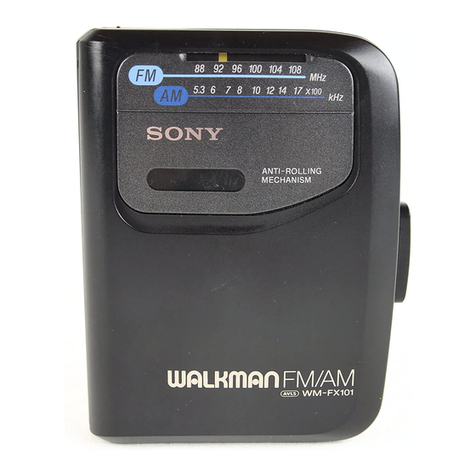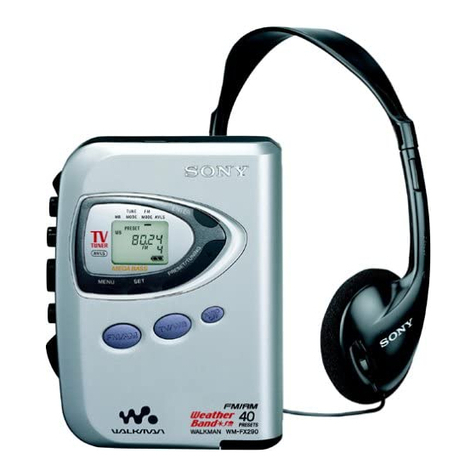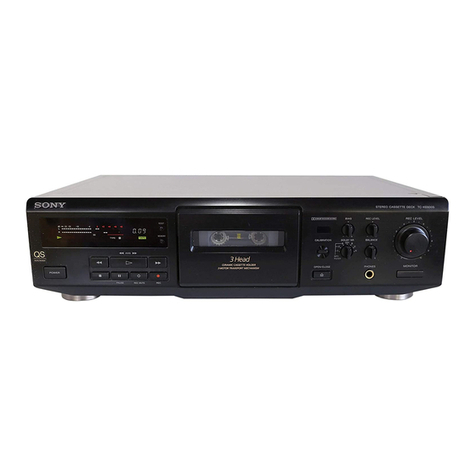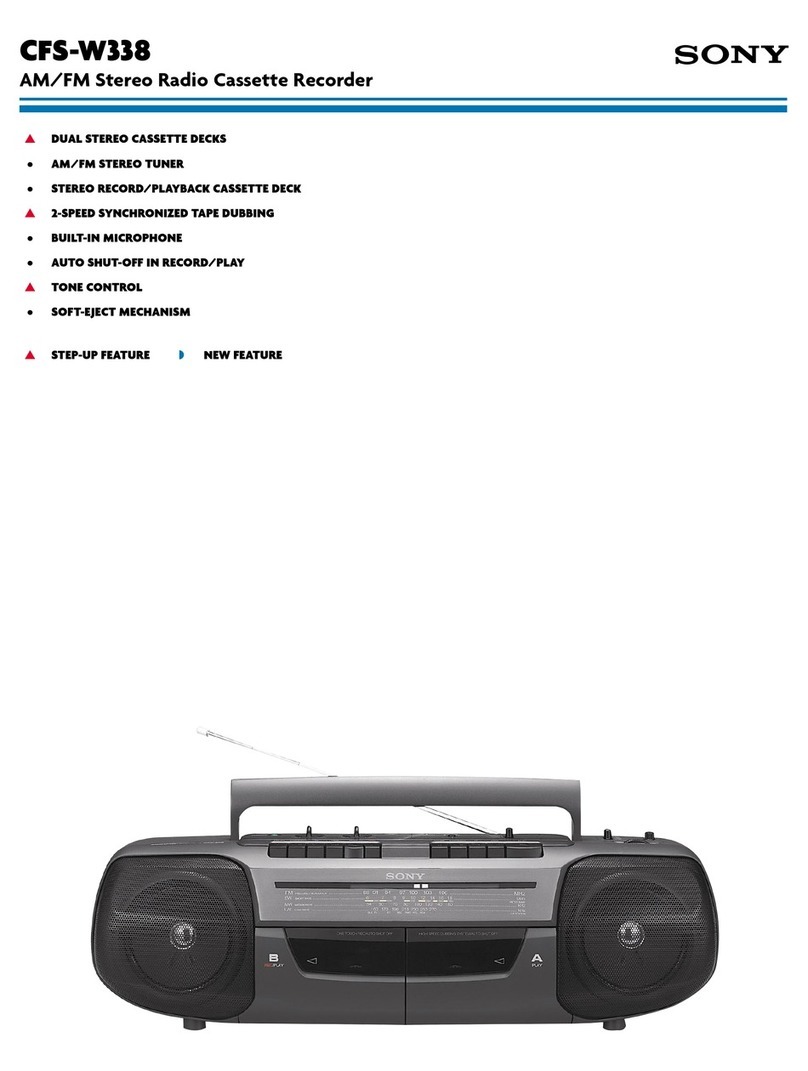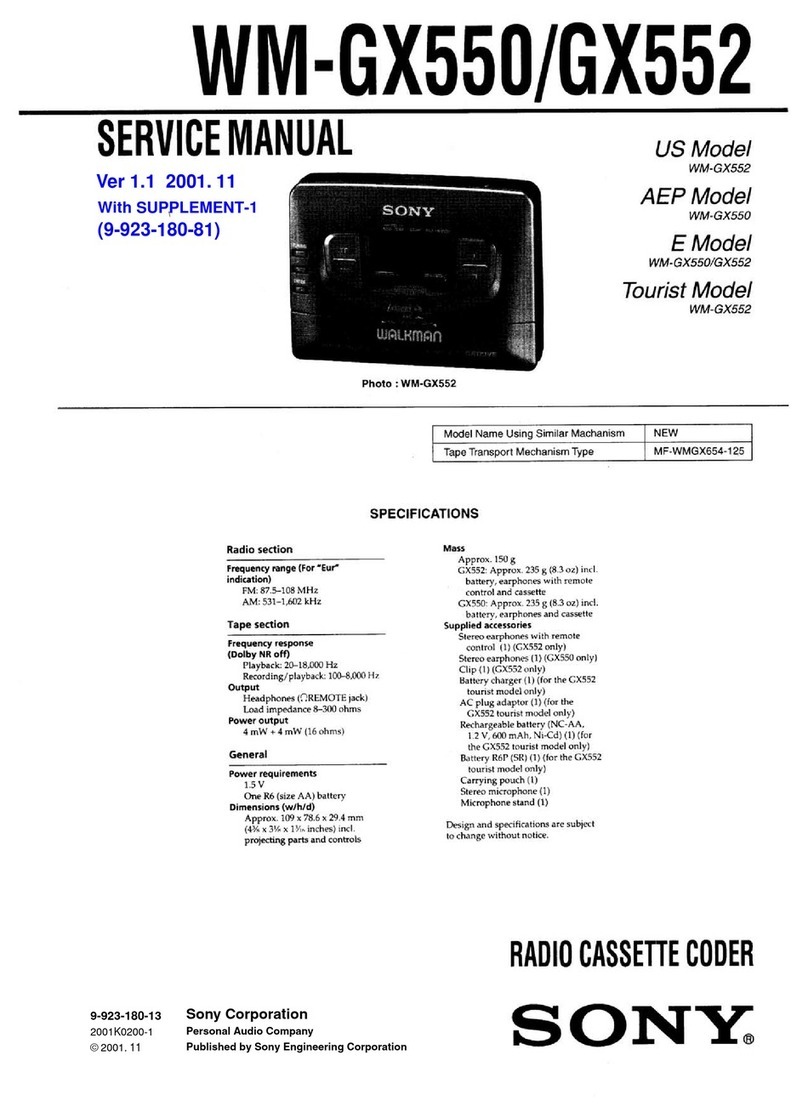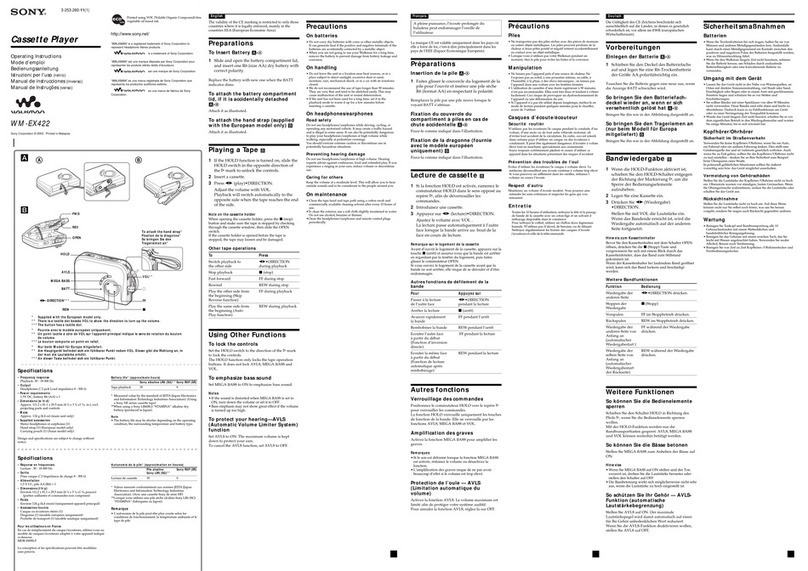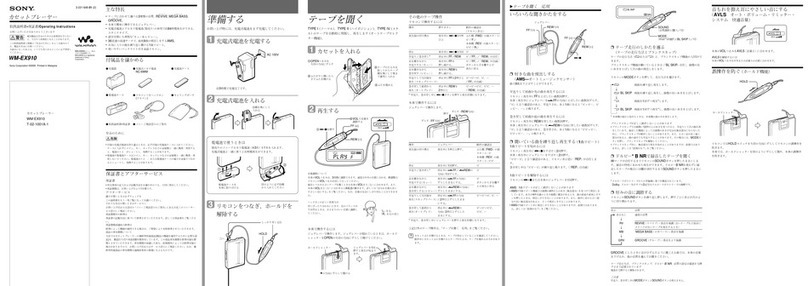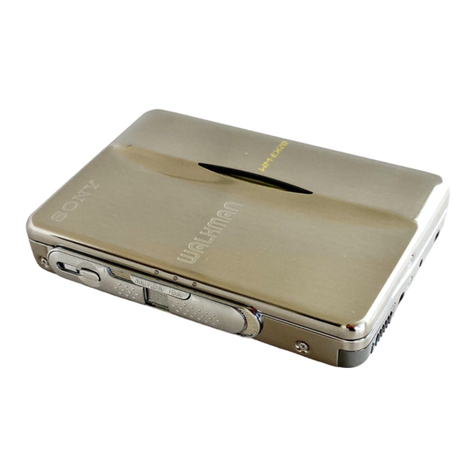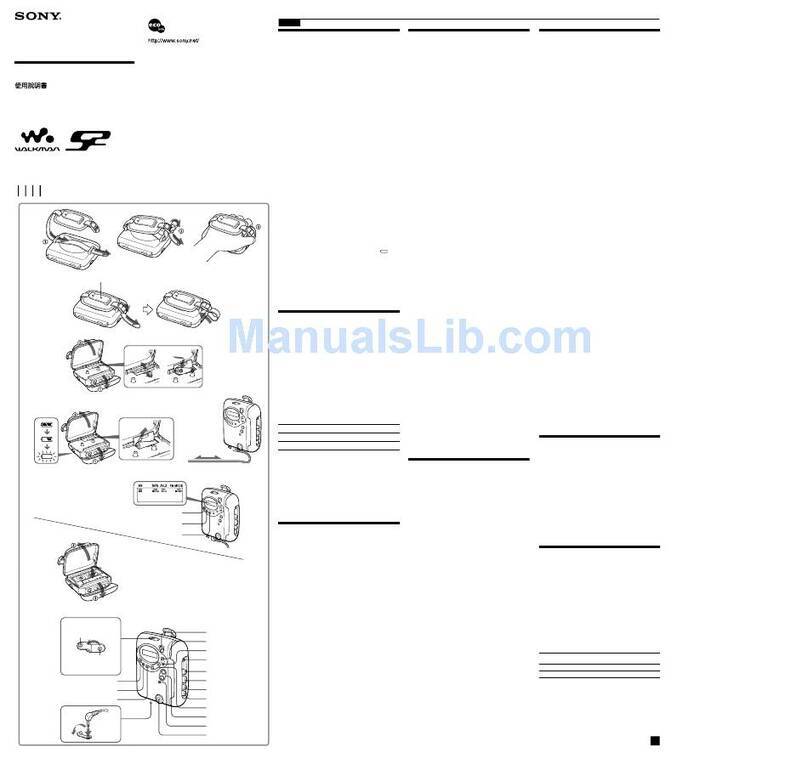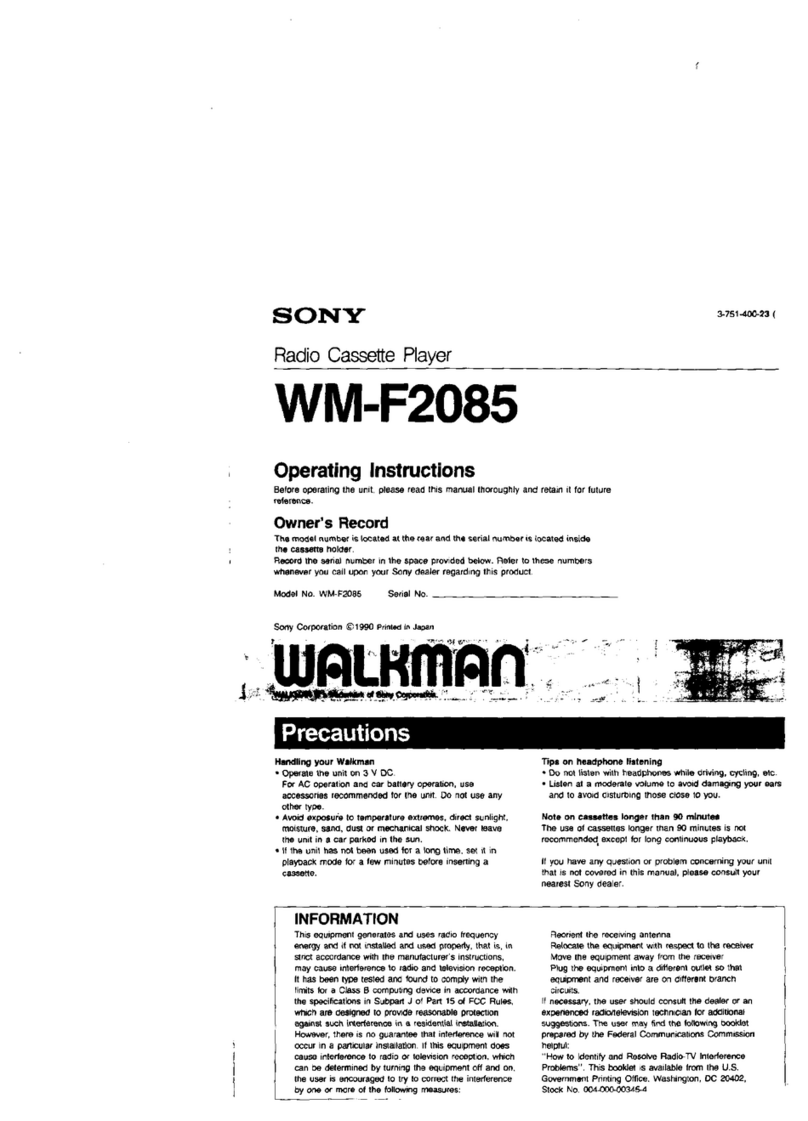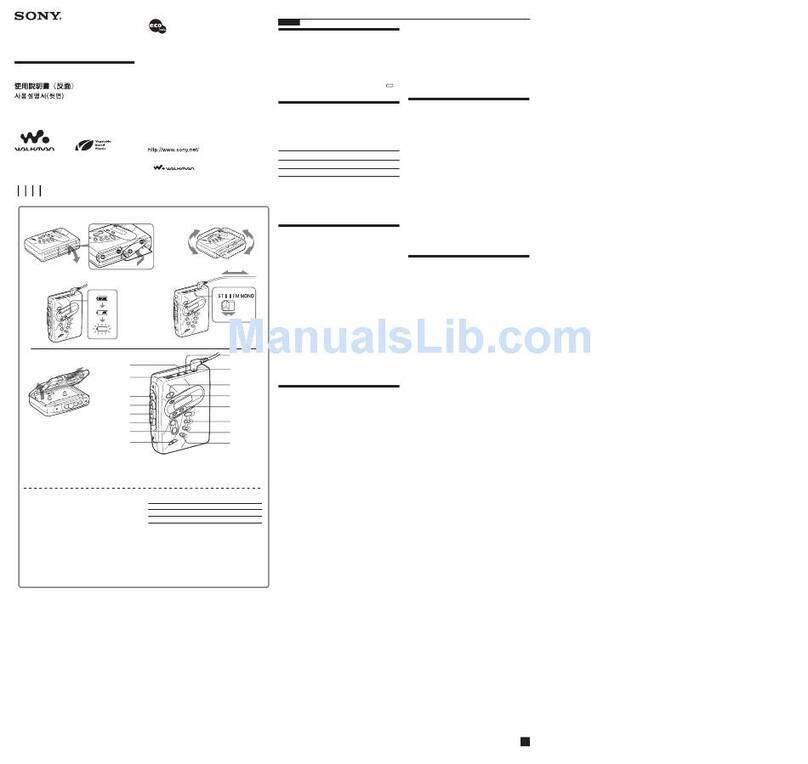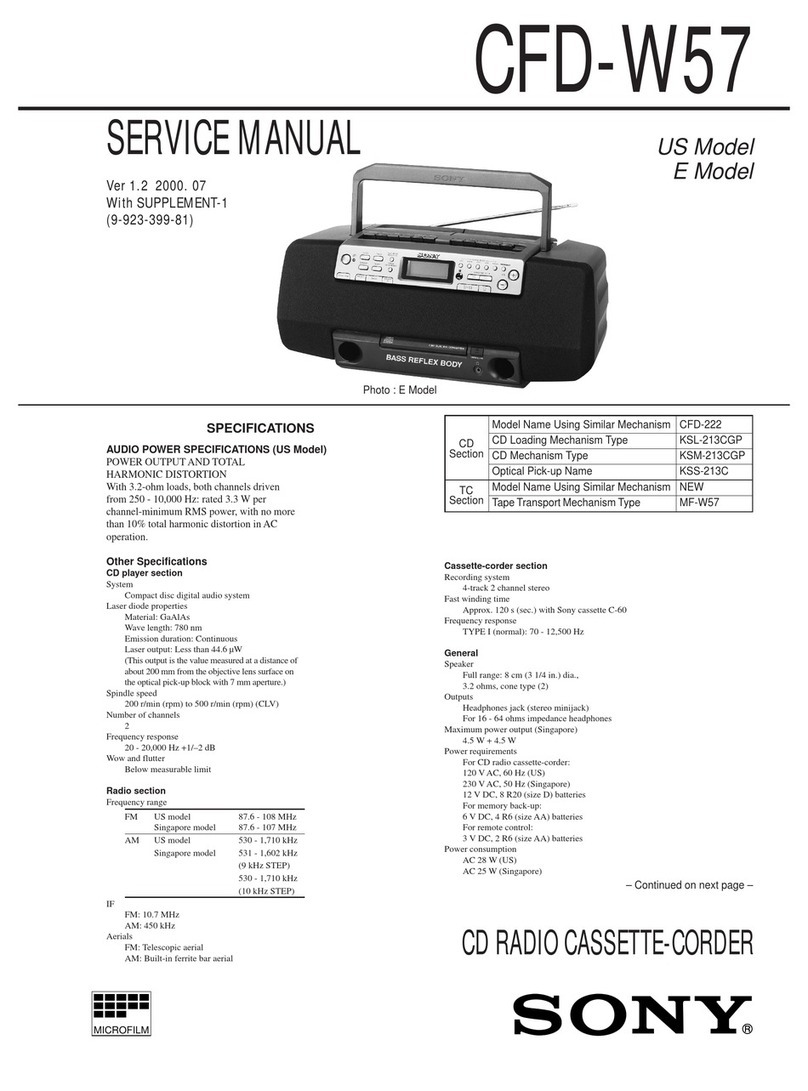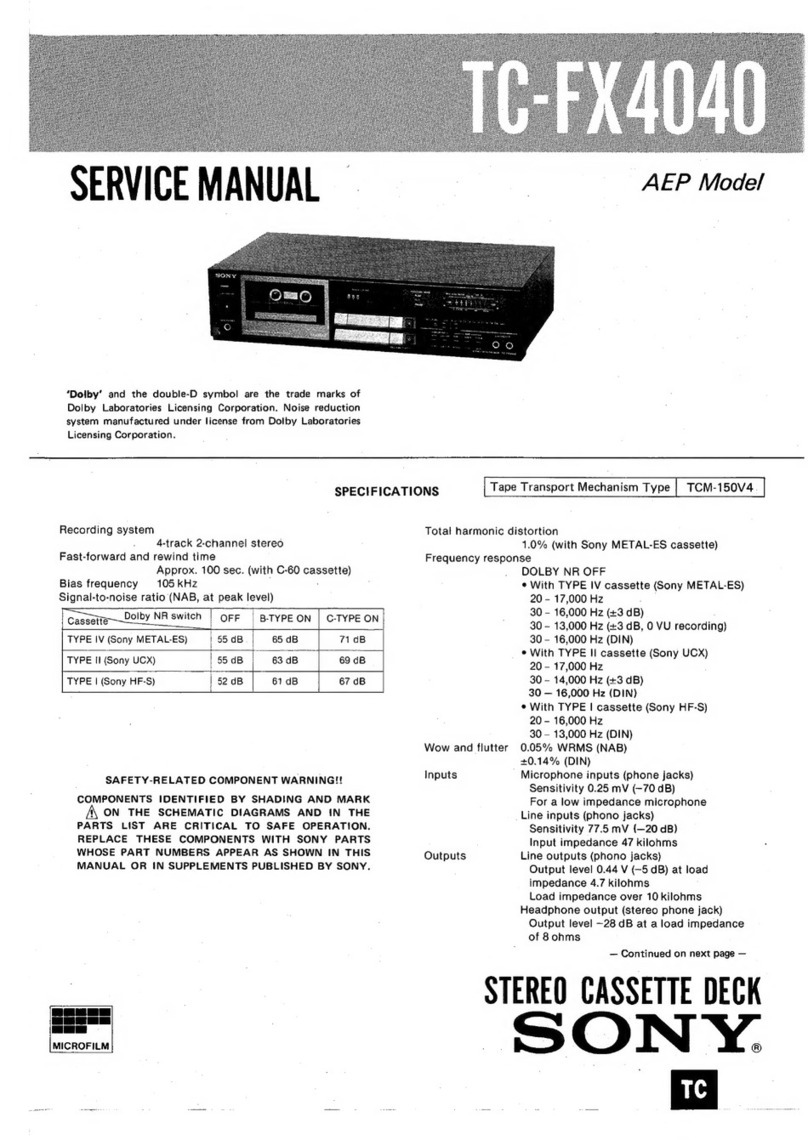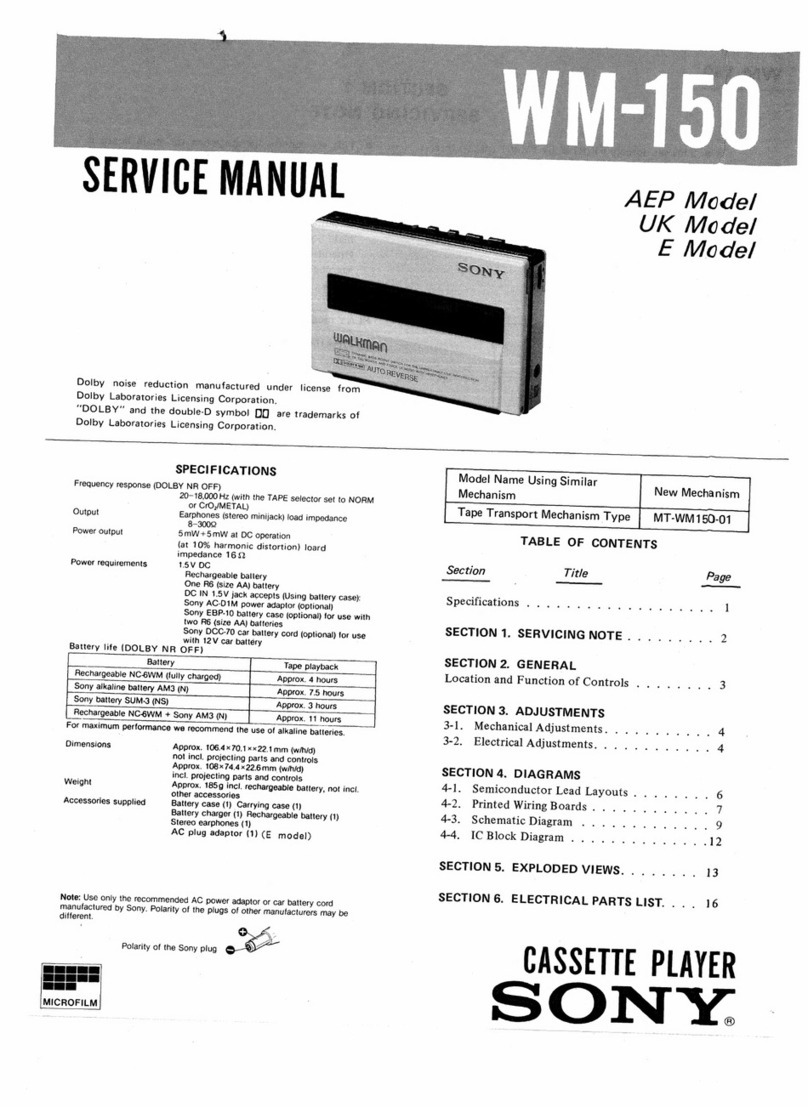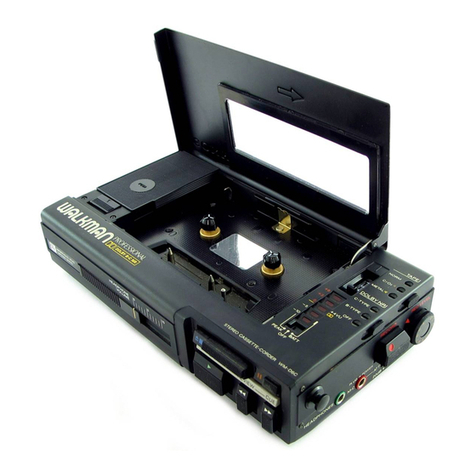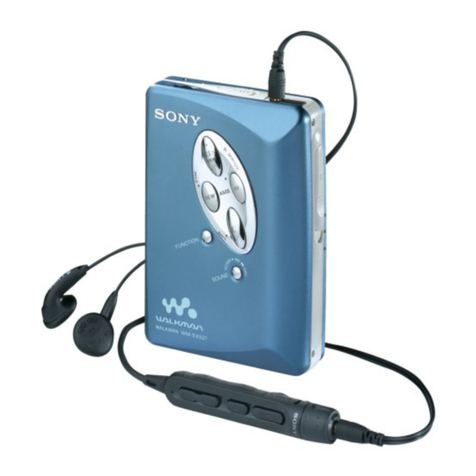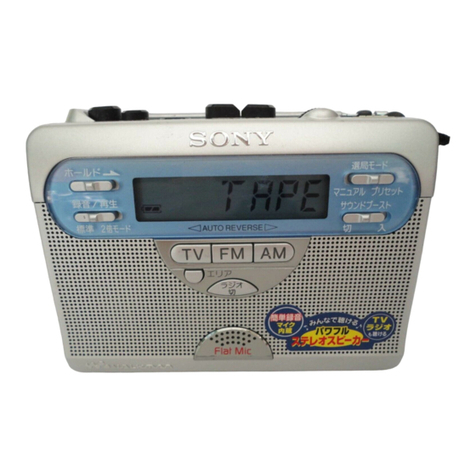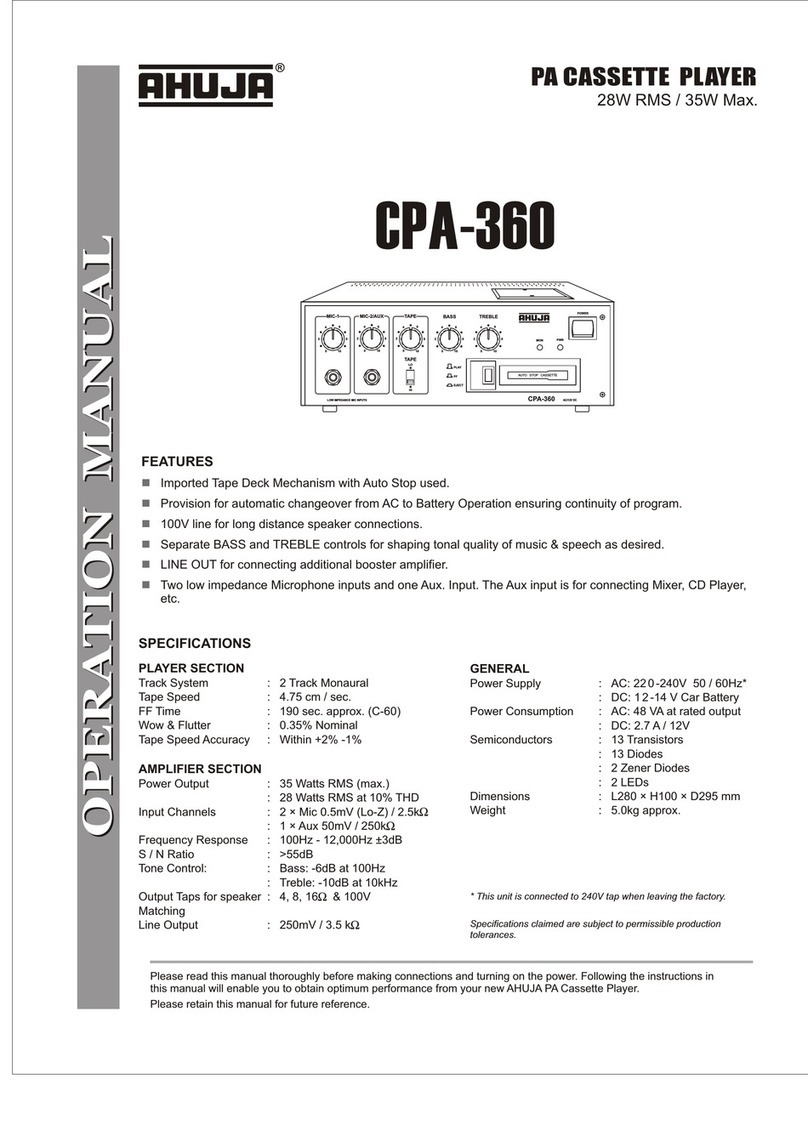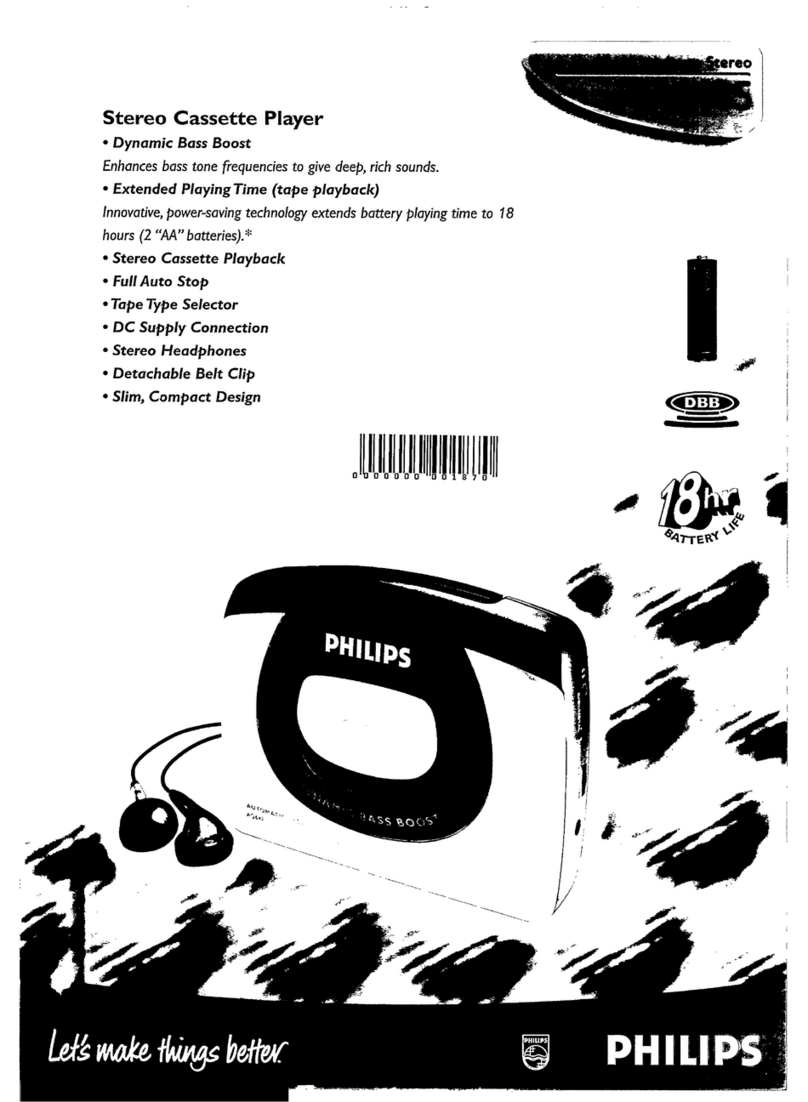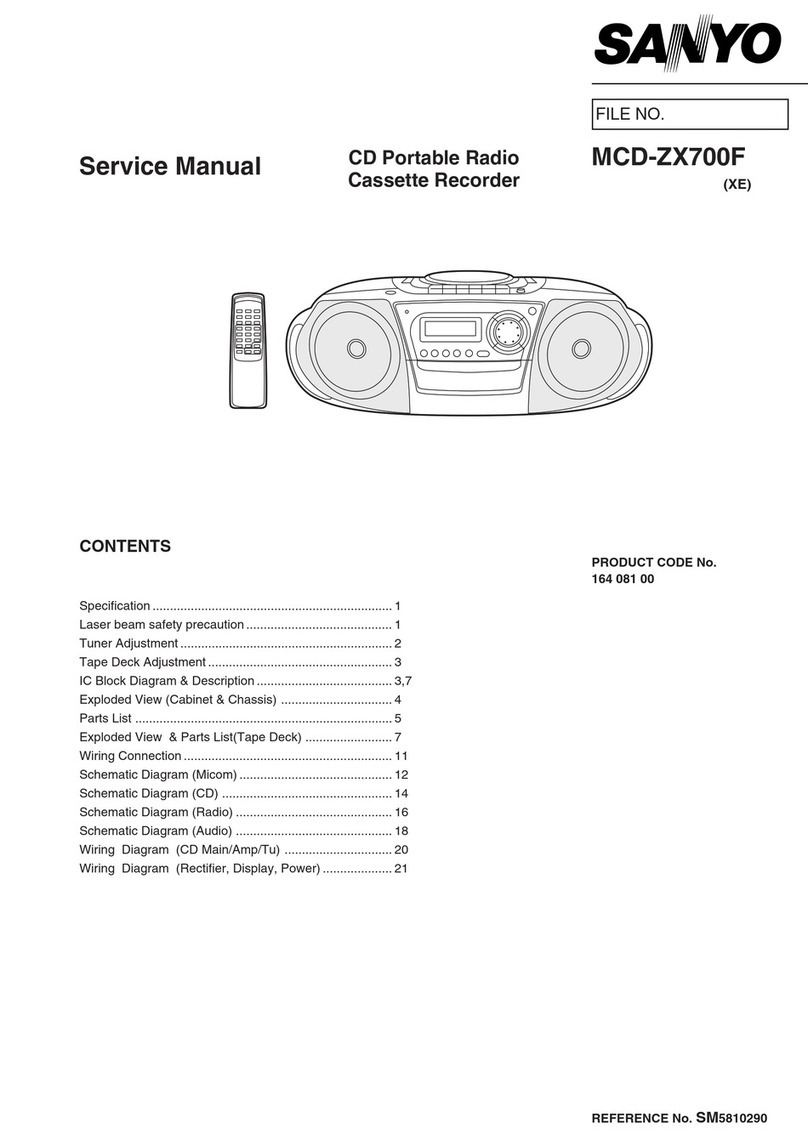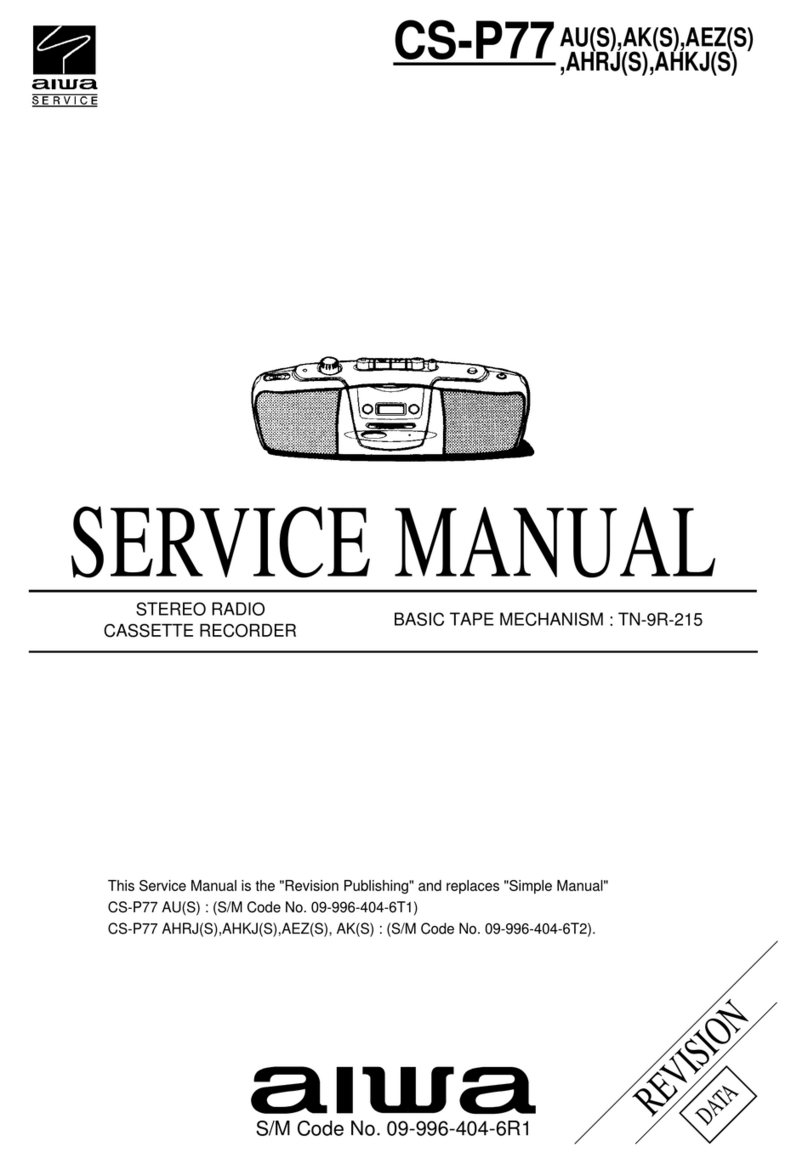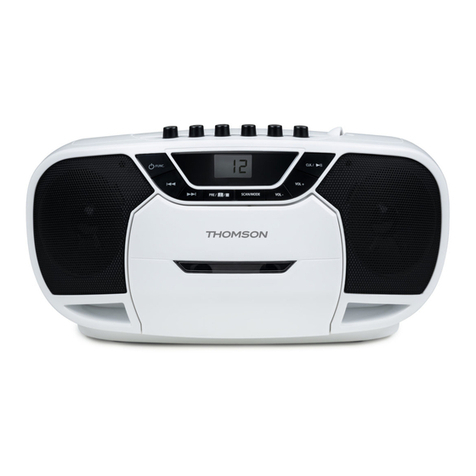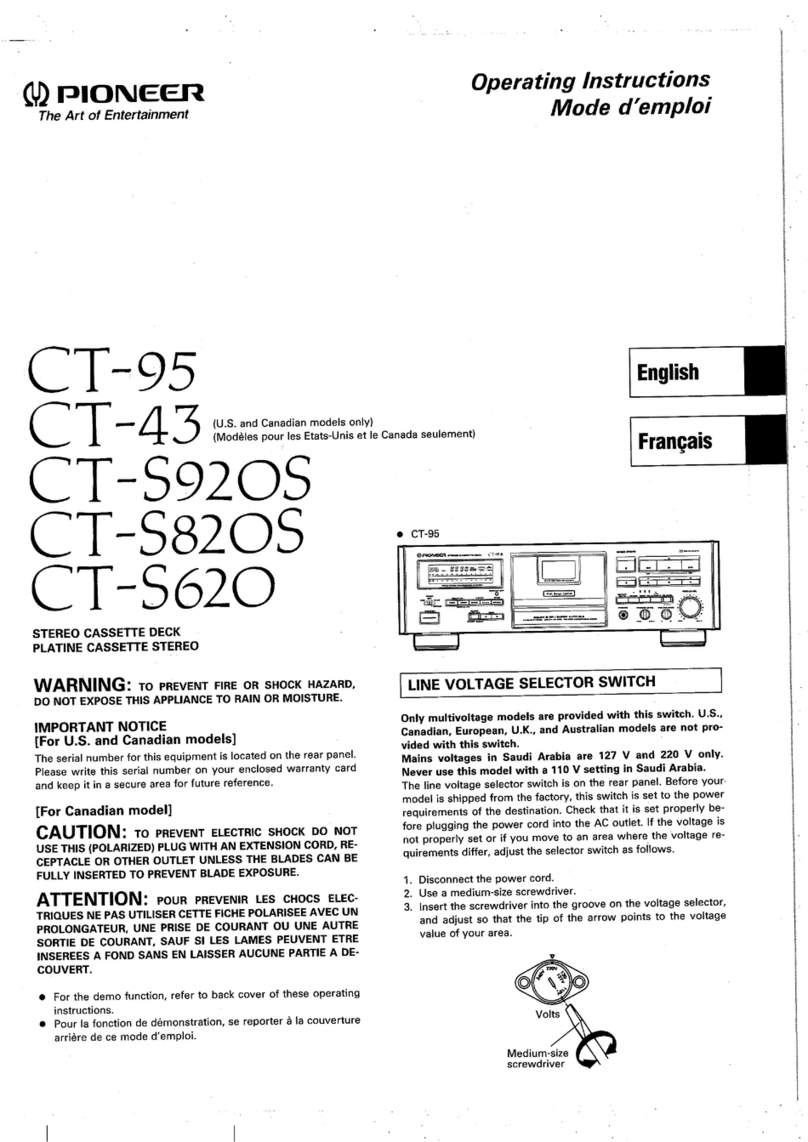
Press or slide
pSTOP
PAUSE cin the direction of the
arrow
To release pause playback, release
PAUSE c*.
Press and hold )FF/CUE and release
it at the point you want
Press and hold 0REW/REVIEW and
release it at the point you want
)FF/CUE during stop
0REW/REVIEW during stop
rREC
0REW/
REVIEW
pSTOP
PAUSE
rREC
MIC TAPE COUNTER
EAR
VOR (TCM-459V)
MIC SENS (TCM-459V)
BATT/REC
TCM-465V
VOR
BATT/REC
CUE MARKER
3-867-917-11(1)
Cassette-Corder
TCM-465V/459V/36
Sony Corporation 1999
About This Manual
The instructions in this manual are for TCM-465V,TCM-
459V and TCM-36. Before you start reading, check your
model number. TCM-459V is the model used for illustration
purposes. Any differences in operation are clearly indicated
in the text, for example, “TCM-459V only”.
XXXX
A
a
bc
E
D
C
B
a
b
c
d
e
BATT
REC
BATT
REC
BATT
REC
flash
light
light
A
Side A
DC IN 3V
AC power adaptor
Pinch-roller
Cotton swab
When batteries
are new
When batteries
become weak
Replace batteries CapstanErase head
English
Welcome!
Thank you for purchasing the Sony Cassette-Corder.
Some features are:
•VOR (Voice Operated Recording) system that starts and
stops recording automatically in response to the sound, to
save tapes and batteries (TCM-465V/459V only).
•SPEED CONTROL function that lets you increase or
decrease the tape playback speed.
•High sensitive flat mic picks up a wide range of sound
clearly (TCM-459V/36 only).
•Pop-up microphone system allows you to use the
microphone properly by adjusting it to the situation (TCM-
465V only).
When the microphone is in the standing position, it works
as an unidirectional microphone and picks up sound
coming from the front side clearly.
When the microphone is at the flat position, it picks up a
wide range of sound clearly.
•Cue marker function to mark a desired portion during
recording (TCM-465V only)
•Three BATT/REC lamps indicate the remaining battery
power in two steps and the ilamp indicates when to
replace the batteries.
zGetting Started
Preparing a Power Source
Choose one of the following power sources.
Dry Batteries (see Fig. A-a)
Make sure that nothing is connected to the DC IN 3V jack.
1Open the battery compartment lid.
2Insert two size R6 (AA) batteries (supplied to TCM-36
and tourist model of TCM-465V only) with correct
polarity and close the lid.
Notes
•Do not charge a dry battery.
•Do not use a new battery with an old one.
•Do not use different types of batteries.
•When you do not use the unit for a long time, remove the batteries
to avoid any damage caused by battery leakage and subsequent
corrosion.
•Dry batteries will not be expended when another power source is
connected.
To take out the batteries (see Fig. A-b)
To attach the battery compartment lid if it is
accidentally detached (see Fig. A-c)
When to replace the batteries (see Fig.A-d)
Replace the batteries with new ones when the BATT/REC
lamps go off and the ilamp flashes.
The BATT/REC lamps change as illustrated:
Notes
•During FF(CUE) or REW(REVIEW), the ilamp may flash. Only
when the tape does not run properly, replace the batteries.
•In some cases when the unit is used with rechargeable batteries,
only one BATT/REC lamp will light even though the batteries
have been fully charged.
•After the batteries have been used for a while, the BATT/REC
lamps may flash with the playback sound when you turn up the
volume; however, this does not mean that you need to replace the
batteries.
•The unit will play back normally for a while even after the ilamp
flashes. However, replace the batteries as soon as you can. If you
do not, a loud noise may be emitted by the built-in speaker or
subsequent recording will not be done correctly.
•When the tape starts running or at the end of the tape the ilamp
may momentarily light. If the lamp goes off, you do not need to
replace the batteries.
Battery life (Approximate hours) (EIAJ*)
Playback Recording
Sony alkaline LR6 (SG) 11 11
Sony R6P (SR) 3 3
* Measured value by the standard of EIAJ (Electronic Industries
Association of Japan). (Using a Sony HF series cassette tape)
Note
The battery life may shorten depending on the operation of the
unit.
House Current (see Fig. A-e)
Connect the AC power adaptor to DC IN 3V and to the wall
outlet. Use the AC-E30HG AC power adaptor (not supplied).
(For TCM-36: For Japan use the AC-E30M, not supplied) Do
not use any other AC power adaptor.
Note
Specifications for AC-E30HG varies for each area. Check your local
voltage and the shape of plug before purchasing.
zOperating the Unit
Recording (see Fig. B-a, b)
You can record right away with the built-in microphone.
Make sure that nothing is connected to the MIC jack.
1Press the counter reset button to reset the tape counter.
2Insert a normal (TYPE I) tape with the side to start
recording facing the cassette holder.
3For TCM-465V/459V:
1Set VOR to:
ON to start and pause recording automatically to the
sound.
OFF to start and stop recording manually.
For TCM-459V:
2Set MIC SENS to select the sensitivity of the
microphone to:
H (high) to record at meetings or in a quiet and/or
spacious place.
L (low) to record for dictation or in a noisy place.
Note
When the sound to be recorded is not loud enough, set the
VOR switch to OFF, or the unit may not start recording.
4For TCM-465V:
•To use the microphone in a standing position
When you record a lecture or a speech, use the
microphone in a standing
position.
1Slide the POP-UP MIC
switch as illustrated.
2Face the microphone
toward the sound source.
Polarity of the plug
•To use the microphone without standing it
When you want to record a
wide range for conversations in
a meeting, etc., use the
microphone at a flat angle.
Place the unit on a hard surface
such as a desk with the cassette
holder side up so that the flat
mic can record effectively.
For TCM-459V/36:
Place the unit on a hard surface such as a desk with the
cassette holder side up so that the flat mic can record
effectively.
Note
When using the microphone in a standing position, the
sensitivity will be higher than the flat mic.
5Press rREC.
Recording starts.
While the tape runs, the BATT/REC lamp lights and
flickers depending on the strength of the sound.
At the end of the tape, recording stops and the unit turns off
automatically.
To Press or slide
Stop recording pSTOP
Pause recording PAUSE cin the direction of the arrow
To release pause recording, release
PAUSE c*.
Review the portion Press and hold 0REW/REVIEW
just recorded during recording.
Release the button at the point to start
playback.
* PAUSE cwill be also automatically released when pSTOP is
pressed (stop-pause-release function).
To monitor the sound
Connect an earphone (not supplied) firmly to the EAR jack.
Notes
•Do not use a CrO2(TYPE II) or metal (TYPE IV) tape, otherwise the
sound may be distorted when you play back the tape, or the
previous recording may not be erased completely.
•The SPEED CONTROL switch works in the playback mode only.
Recording will be made independent of this control.
Notes on VOR (Voice Operated Recording) (TCM-465V/
459V only)
•The VOR system depends on the environment conditions. If you
cannot get the desired results, set VOR to OFF.
•When using the VOR system, the unit starts recording only when a
sound is detected, therefore, the beginning of the word may not be
recorded. For an important recording, we recommend setting VOR
to OFF.
Locating the Cue Marker Position (TCM-465V only)
Press CUE MARKER during recording. You will hear a buzz
at the cue marker position when you press FF/CUE or
REW/REVIEW while playing back the tape.
It is convenient to mark at an important part of speech, for
example, during an interview to quickly find that portion by
pressing FF/CUE or REW/REVIEW while playing back the
tape.
Notes
•Cue will not be marked if you press STOP or PAUSE immediately
after having pressed CUE MARKER.
•You may hear noise at the cue marker position during playback
when you are listening to the recording through a sensitive
earphone.
To prevent a tape from being accidentally recorded
over (see Fig. B-c)
Break out and remove the cassette tabs. To reuse the tape for
recording, cover the tab hole with adhesive tape.
Recording from Various Sound
Sources (see Fig. C)
Recording with an External Microphone
Connect a microphone to the MIC jack. The raised dot near
the MIC jack identifies as the jack for a microphone, not an
earphone. Use a microphone of low impedance (less than 3
kilohms) such as ECM-T115 (not supplied).
When using a plug-in-power system microphone, the power
to the microphone is supplied from this unit.
Note
When recording with an external microphone, the VOR system
may not work properly because of the difference in sensitivity.
Recording from Another Equipment
Connect another equipment to the MIC jack using the RK-
G64HG connecting cord (not supplied). (For TCM-36: For
Japan use the RK-G64, not supplied)
Playing a Tape (see Fig. D)
1Insert a cassette with the side to start playing facing the
cassette holder.
2Adjust the tape playback speed.
Set SPEED CONTROL to:
SLOW (slow) to play back a tape slower.
Center position to playback a tape at normal speed.
FAST (fast) to playback a tape faster.
3Press (PLAY then adjust the volume. There is a raised
dot to show the direction to turn down volume beside
VOL.
At the end of the tape, playback stops and the unit turns off
automatically.
To
Stop playback/stop fast
forward or rewind
Pause playback
Search forward during
playback (CUE)
Search backward during
playback (REVIEW)
Fast forward**
Rewind**
Start recording
during playback
* PAUSE cwill be also automatically released when pSTOP is
pressed (stop-pause-release function).
** If you leave the unit after the tape has been wound or
rewound, the batteries will be consumed rapidly. Be sure to
depress pSTOP.
zAdditional Information
Precautions
On power
•Operate the unit only on 3V DC. For AC operation, use the
AC power adaptor recommended for the unit. Do not use
any other type. For battery operation, use two size R6 (AA)
batteries.
On the unit
•Do not leave the unit in a location near heat sources, or in a
place subject to direct sunlight, excessive dust or
mechanical shock.
•Should any solid object or liquid fall into the unit, remove
the batteries or disconnect the AC power adaptor, and
have the unit checked by qualified personnel before
operating it any further.
•Keep personal credit cards using magnetic coding or
spring-wound watches etc. away from the unit to prevent
possible damage from the magnet used for the speaker.
•If the unit has not been used for a long time, set it in the
playback mode and warm it up for a few minutes before
inserting a tape.
On tapes longer than 90 minutes
We do not recommend the use of tapes longer than 90
minutes except for a long continuous recording or playback.
They are very thin and tend to be stretched easily.
If you have any questions or problems concerning your unit,
please consult your nearest Sony dealer.
Troubleshooting
Should any problem persist after you have made these
checks, consult your nearest Sony dealer.
You cannot press rREC.
mThe tab on the tape has been removed.
You cannot press (PLAY.
mThe tape has reached the end. Rewind the tape.
The unit does not operate.
mThe batteries have been inserted with incorrect
polarity.
mThe batteries are weak.
mPAUSE cis slid in the direction of the arrow.
mThe AC power adaptor or car battery cord is not firmly
connected.
mThe batteries have been inserted, but simultaneously
the AC power adaptor is connected and not to be done
to the wall outlet.
No sound comes from the speaker.
mThe earphone is plugged in.
mThe volume is turned down completely.
Tape speed is too fast or too slow in the playback
mode.
mSPEED CONTROL is set at a point other than the
center.
The sound drops out or comes with excessive noise.
mThe volume is turned down completely.
mThe batteries are weak.
mThe heads are contaminated. See “Maintenance.”
Recording cannot be made.
mConnection is made incorrectly.
mThe batteries are weak.
mThe record/playback head is contaminated.
mFor TCM-465V: Change the flat mic or pop-up mic.
mFor TCM-459V: MIC SENS has been set to the
improper position when VOR function works.
Recording is interrupted.
mFor TCM-465V/459V: VOR is set to ON. When you do
not use VOR, set it to OFF.
Recording cannot be erased completely.
mThe erase head is contaminated.
mRecording or erasing is being made using recorded
CrO2(TYPE II) or metal (TYPE IV) tape.
Maintenance (see Fig. E)
To clean the tape heads and path
Wipe the heads, pinch rollers, and the capstans with a cotton
swab moistened with alcohol every 10 hours of use.
To clean the exterior
Use a soft cloth slightly moistened in water. Do not use
alcohol, benzine or thinner.
Specifications
Recording system
2-track 1 channel monaural
Frequency range
250 - 6,300 Hz
Speaker
Approx. 3.6 cm (17⁄16 in.) dia.
Power output
300 mW (at 10 % harmonic distortion)
Input
Microphone input jack (minijack) sensitivity 0.2 mV for 3 kilohms
or lower impedance microphone
Output
Earphone jack (minijack) for 8 - 300 ohms earphone
Variable range of the tape speed
from +30% to –15%
Power requirements
•Two size R6 (AA) batteries (supplied to TCM-36 and tourist
model of TCM-465V only): 3V DC
DC IN 3 V jack accepts:
•AC-E30M (TCM-36 only) or AC-E30HG AC power adaptor (not
supplied) suitable in the country where the unit is to be used.
•Sony DCC-E230 car battery cord (not supplied) for use on 12 V
car battery.
Dimensions (w/h/d) (incl. projecting parts and controls)
TCM-465V: Approx. 116 ×91 ×43mm (45⁄8×35⁄8×13⁄4in.)
TCM-459V/36: Approx. 116 ×91 ×38mm (45⁄8×35⁄8×11⁄2in.)
Mass (not incl. batteries)
TCM-465V: Approx. 200 g (7.1 oz.)
TCM-459V/36: Approx. 195 g (6.9 oz.)
Supplied accessories
R6 (size AA) batteries (2) (TCM-36 and tourist model of TCM-
465V only)
Design and specifications are subject to change without notice.
Operating Instructions
Operating Instructions
MIC (PLUG IN POWER)
SPEED CONTROL
(PLAY
PAUSE
VOL
pSTOP
0REW/REVIEW
)FF/CUE
Record/playback head
Tab for side A
microphone
POP-UP MIC
switch
Flat mic
